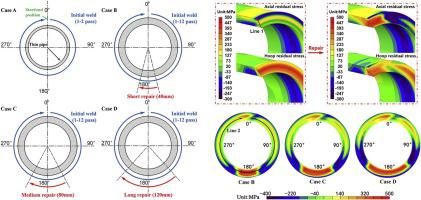Journal of Manufacturing Processes ( IF 6.2 ) Pub Date : 2020-09-15 , DOI: 10.1016/j.jmapro.2020.09.006 Peiyuan Dai , Yifeng Wang , Suo Li , Shijie Lu , Guangjie Feng , Dean Deng

|
Repair welding is widely used to repair defects such as fatigue crack and stress corrosion crack in metal structures for prolonging their service lives. However, the residual stress induced by repair welding potentially threatens the safety of the repaired weldments, especially stainless steel pipe structures and pressure vessels used in nuclear power plants. Based on the MSC. Marc software, a thermal elastic plastic finite element method with the consideration of full 3-D model, moving heat source and advanced material model was developed to simulate residual stress distribution induced by repair welding. In the current study, the effectiveness of the developed computational approach was verified by a two-pass thin-walled butt-welded SUS304 steel pipe mock-up at first. Then, the residual stress distributions in a medium thickness SUS304 steel pipe butt-welded joint before and after repair welding were investigated numerically. The simulation results show that the peak value of axial residual stress after repair welding was significantly increased, while the variation of the maximum value of hoop residual stress was limited. In addition, the effect of repair length on the feature of residual stress distribution was studied numerically. The numerical results indicate that the peak value of repair-induced residual stress decreases with the repair length. The main reason is that the longer the repair welding length is, the less local constraint will be. The residual stress distribution in the repair area at service temperature was also discussed in this study. The results obtained from the current study will be helpful in evaluating the structural integrity of repaired weldments.
中文翻译:

SUS304不锈钢管对焊接头补焊残余应力的有限元分析
补焊广泛用于修复金属结构中的疲劳裂纹和应力腐蚀裂纹等缺陷,以延长其使用寿命。但是,由修复焊接引起的残余应力可能会威胁到修复后的焊件的安全性,尤其是核电站中使用的不锈钢管结构和压力容器。基于MSC。开发了Marc软件,该软件考虑了完整的3-D模型,移动的热源和先进的材料模型,从而模拟了修复焊接引起的残余应力分布。在当前的研究中,首先通过两遍薄壁对焊SUS304钢管模型验证了所开发的计算方法的有效性。然后,数值研究了中厚SUS304钢管对焊接头修复焊前后的残余应力分布。仿真结果表明,补焊后轴向残余应力峰值明显增加,而环向残余应力最大值的变化受到限制。此外,数值研究了修复长度对残余应力分布特征的影响。数值结果表明,修复引起的残余应力的峰值随修复长度的增加而减小。主要原因是修复焊接长度越长,局部约束越小。研究中还讨论了维修温度下维修区域的残余应力分布。


























 京公网安备 11010802027423号
京公网安备 11010802027423号